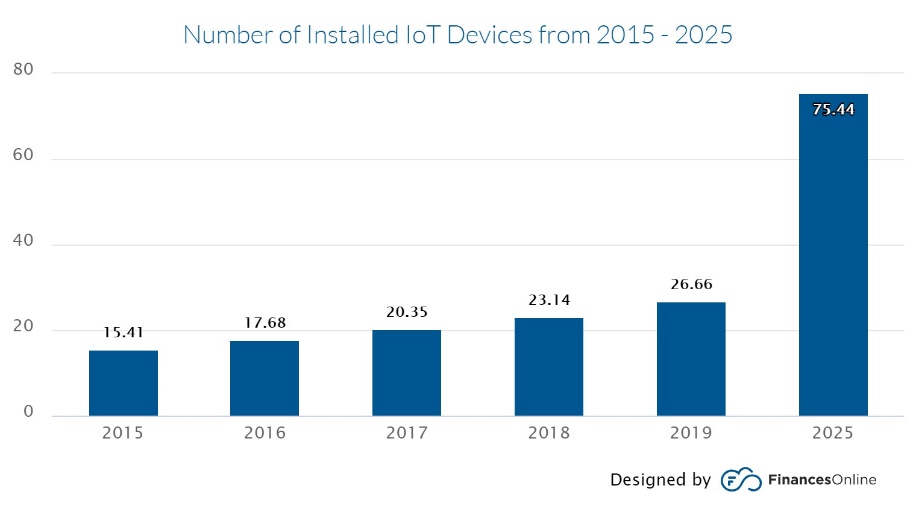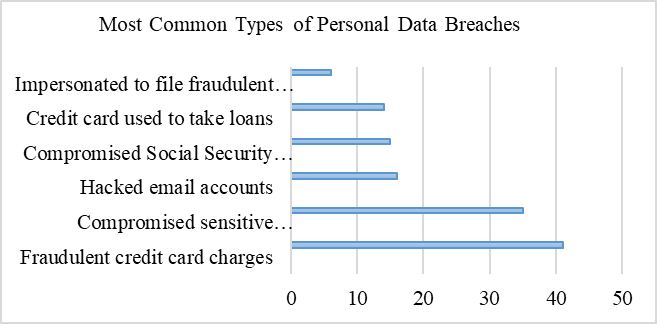Abstract
The work was done to look into the new technology - Internet of Things. Specifically, its effect on the business, which by appliance opens the wide range of the different services. At the beginning, the invention itself was explained, by briefly outlining the way it works and its implementation in other extents, without considering the field of business. Also, this article covers literature review on the chosen subject. The influence of the invention on the businesses and the main improvements, that it brings within itself. The main advantages of the implementation of the invention into the businesses were considered, such as: data gathering and exchange, management of goods and labour usage. Similarly, the disadvantages were mentioned as well. At the last, comparison of the results such us global costs spent on the matter of subject and number of employed appliances took place, and most common treats that occur with the instalment of it.
Keywords: Internet of ThingsIoTbusinessdata exchangesmart devicesnew technologies
Introduction
In the present age, which is often called the information age, data is increasingly valuable and with it its collection, storage, processing and transfer, as well as its subsequent use. Therefore, to facilitate the above processes, there is a need to implement information systems of information technology in all areas of people's activities.
Few decades ago the only thing that one could imagine being connected to the internet would be computers, but as time and with it the technologies progress, we start noticing, that the most familiar things for us, with which we interact in everyday life, have access to the Internet. They connect to the internet for access and data exchange, even without any human involvement, which resulted to the appearance of such a term as the “Internet of things”
The Internet of things or IoT is a technology that integrates devices into a computer network and allows them to gather and analyse, process and transfer data to other objects using software, applications and hardware. In other words, (IoT) devices share data in both wired and wireless network. It is significant to note, that the infrastructure of these devices is represented by combination of hardware, software and communications. Typically, IoT systems consist of a network of appliances (smart devices) and the cloud (cloud storage) platform to which they are connected. The first step is the gathering and analysis of data, and afterword the gathered data will be sent to the cloud. IoT is currently employed in many areas of human activity: business, healthcare, industry, transport, etc. Therefore, the invention will increase automation in homes, schools, stores, and in many industries (Attaran & Gunasekaran, 2019).
Problem Statement
In the present days we deal with the inventions and their integration in our life is inevitable. With the transformation or establishment of an invention the life sometimes dramatically changes and the need to adapt is essential for the prosperity of life and surroundings. Hence, the necessity of understanding the matter of subject and its possible effect on the way we live and communicate is essential.
Research Questions
As it was stated above, that invention (the matter of subject) will have a vast influence on the way we live and communicate, but there are other aspects, that the technology of IoT will effect on, for example, businesses. Therefore, this study will look into the influence or the alterations the it will bring into the businesses.
The influence of the innovation to the businesses.
The advantages and disadvantages of implication of the IoT.
Purpose of the Study
The following work is done to illustrate what is the Internet of Things and how it does work in the present days. The mighty influence it could have on the way we live and communicate.
Research Methods
It is fair to mention, that the innovation or IoT is on its way and finally in the progression of getting a pace. In addition, it can be mentioned, that with the developments of the new invention, which are directly made, and are suitable for the IoT, one can assume that IoT has started to transform business landscape (Attaran, 2017). The new technology wont only influences on the small piece of the businesses, but spread out to the industries such as: transportation and manufacturing, energy, healthcare etc. Similarly, smaller appliances, that can be found in the household, workplaces and outdoor, like electric devices (TV, air-conditioner, electric kettle, lamp, dishwasher, vacuum cleaner and so on) (Konsbruck, 2001; Golubeva et al., 2020). Consequently, the technology at its highest peak will conquer and change the way we live dramatically. However, the article will look into the effect of Internet of Things to the business.
The present days fairly can be named as the era of technology and development and emergence of new technology changes and restructures everyday routine; hence businesses are trying to employ the new emergences and take advantages from them (Aman, 2017). It was stated by (Suzanne, 2018) that the influence of Internet of Things is most felt on the business not because it transformed the approaches of different business operations, but in a way how the information is collected and exchanged. Consequently, the influence of the Internet of Thing to the business is vast.
Data collection
There is no secret to say that data is the key for any business to be successful in the market. By the imbedding of Internet of Things to the business there has been a dramatic change in the way businesses handle gathering and exchange of data. IoT appliances can be utilized to track and record data from the devices of the customers and thus refining and making them smarter in a way, that they will suggest a better user experience for the future use. The data assembly can be utilized to analyse buyer cycle, customer requirements, for future improvements, marketing and for advertisement (with the use of targeting) (Lokesh, 2019; Suzanne, 2018). In other words, the more data flows the grater interface with customers. Lately, there has been new Internet of Things invention. It uses different gadgets, that are arranged in a way so they can gather enormous amount of data that was unreachable before. It is clear that with the collection of quality and quantity information the business will be one step ahead to the success (Naqvi et al., 2017).
Tracking and management
Not all businesses rely on storage and warehousing, but mostly does. Better management leads to the reduction of waste of time and better usage of spends. Therefore, the use of Internet of Things can be applied in this manner for atomization the beforementioned processes. With the usage of remote scanners Internet of Things can be applied to help business track the stock of things. The technology can track goods directly from the assembling office to its distribution center to conveyances. Also, the technology can be directly applied to stock administration, which will lead to the less usage of labor (working stuff) in the process (Mentsiev et al., 2019a, 2019b).
Labor
It is obvious that with the implementation of the innovation the human interaction will be less. Automation is an essential part of any business to increase its productivity, but in other way it sometimes means the reduction of human intervention.
The list of usability of the innovation can go on with the useful applications. The advantages of using the innovation in boosting business is vast. The main advantages of it are that it can embed atomisation to all processes of the businesses, therefore reduction in both time and money waste.
Drawbacks
As any other inventions IoT has its own disadvantages. First thing that comes with the usage of the innovation are: privacy, job loss, dependability and complexity (Alkemi, 2018; Mentsiev & Chebieva 2019). In today’s tech-driven world, we all use devises that are connected to the internet, thus the vulnerability of innovation is that the data collected is in the risk of being leaked. Similarly, the personal or confidential information of the customers can be hacked as well. Second drawback is not related to the business, but rather to the workers. As it was mentioned before automatization of the work flow will reduce the human involvement. The last one is complexity and dependability. The implementation of the innovation in the business might have some difficulties related to compatibility, new stuff needed, changing the whole structure of business and so on, therefore comes the dependability on the technology.
Findings
This paragraph will be devoted to the statistics over the time. By 2022 the global spending on the matter of subject is predicted to be around 1 trillion U.S. dollars. The global spending on the invention goes as follows: 2018 – 646 and 2019 - 726 billion U.S. dollars. And there is predicted values such as 2022 – 1 and 2023 – 1.1 trillion U.S. dollars. The big difference between 2018 -2019 and 2019 – 2023 is explained as the introduction of 5G technology will drive the market growth in the coming year. By the data collected in 2019 the most invested went as follows: manufacturing operations, which is on the first place; production asset management goes second; smart home is at 4 and last one is freight monitoring.

By observing Figure

Conclusion
To conclude, the work looks into the new technology of Internet of Things that will change the way businesses works. It is obvious that the technology will impact not just businesses, but all the other areas that yet to be explored by it. As the new technology emerges is good to be ready for the big changes. It is clear, that the Internet of Things will grow and scope more and more areas by restructuring and improving them.
References
- Alkemi, R. (2018). Pros & Cons of Internet of Things. https://www.redalkemi.com/blog/post/pros-cons-of-internet-of-things
- Aman, C. (2017). What The Internet Of Things Mean For Businesses. https://www.techjini.com/blog/internet-things-iot-businesses/
- Attaran, M., & Gunasekaran, A. (2019). Blockchain-enabled technology: the emerging technology set to reshape and decentralise many industries. International Journal of Applied Decision Sciences, 12.
- Attaran, M. (2017). The Internet of Things: Limitless Opportunities for Business and Society. Journal of Strategic Innovation and Sustainability, 12.
- Finances online (2020). 37 Impressive IoT Statistics: 2020 Data Analysis & Market Share. https://financesonline.com/iot-statistics/
- Golubeva, T. I., Linder, N. V., Zoidov, K. Kh., Petrov, V. V., Maksimov, D. A., & Abdulkadirov U. U. (2020). Criterion analysis of cloud-based tools in database basics training. Revista Inclusiones, 7(S2-2), 520-534.
- Konsbruck, R. L. (2001). Impacts of Information Technology on Society in the new Century. Route de Chavannes. https://www.zurich.ibm.com/pdf/news/Konsbruck.pdf
- Lokesh, G. (2019). How Internet of things (IoT) is transforming the future business landscape. https://medium.com/faun/how-internet-of-things-iot-is-transforming-the-future-business-landscape-21f0e8b702c7
- Mentsiev, A. U., & Chebieva H.S. (2019). Modern Internet Security Threats and Countermeasures. (overview). Engineering Herald of the Don., 3(54), 16.
- Mentsiev, A. U., Gerikhanov, Z. A., & Isaev, A. R. (2019a). Automation and IoT for controlling and analysing the growth of crops in agriculture. Journal of Physics: Conference Series, 1399.
- Mentsiev, A. U., Supaeva, Kh. S., & Isaev, A. R. (2019b). Advancement of mechanical automation in the agriculture sector and overview of IoT. Journal of Physics: Conference Series, 1399.
- Naqvi, S., Hassan, S., & Hussain, F. (2017). IoT Applications and Business Models. https://doi.org/10.1007/978-3-319-55405-1_4
- Suzanne, E. (2018). 7 Ways the IoT Can Change the Business World. https://www.iotevolutionworld.com/smart-home/articles/437712-7-ways-iot-change-business-world.htm
Copyright information

This work is licensed under a Creative Commons Attribution-NonCommercial-NoDerivatives 4.0 International License.
About this article
Publication Date
21 October 2020
Article Doi
eBook ISBN
978-1-80296-089-1
Publisher
European Publisher
Volume
90
Print ISBN (optional)
-
Edition Number
1st Edition
Pages
1-1677
Subjects
Economics, social trends, sustainability, modern society, behavioural sciences, education
Cite this article as:
Magomedov, I. A., Bagov, A. M., & Zolkin, A. L. (2020). Internet Of Things: Future Business. In I. V. Kovalev, A. A. Voroshilova, G. Herwig, U. Umbetov, A. S. Budagov, & Y. Y. Bocharova (Eds.), Economic and Social Trends for Sustainability of Modern Society (ICEST 2020), vol 90. European Proceedings of Social and Behavioural Sciences (pp. 553-558). European Publisher. https://doi.org/10.15405/epsbs.2020.10.03.62

